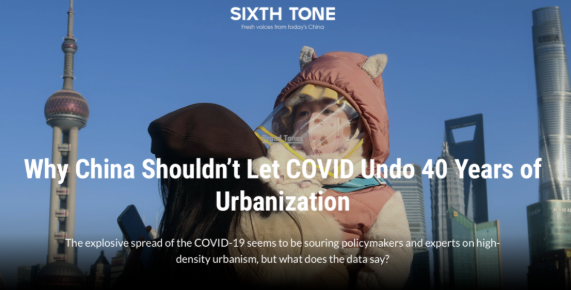Why China Shouldn’t Let COVID Undo 40 Years of Urbanization 2023-12-26
Last week, China brought its “zero-COVID” policy to an abrupt end. According to the latest rules, lockdowns, centralized quarantines, and constant testing are now out, replaced by a renewed emphasis on the struggling economy.
In Shanghai, officials have already stated they will “make every effort to consolidate the momentum of the city’s economic recovery.” But residents and investors cannot and will not forget how the city froze for two months this spring. The citywide lockdown hurt
Shanghai’s economy, effectively halted the flow of people and goods, and left no sector, from industry to the public welfare, untouched.
Shanghai’s was merely the largest of a series of disruptive urban lockdowns over the past three years. Cities across China, from Xi’an in the northwest to Jilin in the northeast and Sanya in the south, were shut down for weeks or months at a time; a few, like Ruili on the southwestern border, were sealed off for far longer.
At the beginning of the pandemic, large, dense cities were viewed as especially susceptible to the spread of infectious diseases. Now, between the economic and psychological fallout of “zero-COVID”, sky-high real estate prices, and growing concern over “urban diseases” like traffic, many Chinese are questioning whether the past four decades of rapid urbanization might have gone too far. Similar criticisms were leveled at large cities in the West during the initial wave of COVID-19 outbreaks there. But are the downsides of population agglomeration really enough to offset its well-documented role in boosting labor productivity, innovation, and consumer service industries?
There are two separate issues under discussion here: population size and population density. In terms of the former, my own research team has found no strong correlation between population size and “urban diseases” like traffic. We found that doubling a city’s population increased average commute times by just 2.3 minutes. The coefficient between the urban congestion index — which measures the delta between commuting during peak hours and off hours — and population size is also very slight.
As for population density, the density of a population is related to a city’s natural and geographical conditions and whether the government strictly controls outward development. According to an analysis of data from large cities around the world, controlling for the population size of a city, high population density alleviates urban congestion, especially in cities with populations in excess of 10 million.
While this may seem counterintuitive, the underlying reasoning is simple: The industrial structure of large cities is usually dominated by services, which require people to meet up with one another. The development of compact, denser cities facilitates this, reducing the distance and costs involved in travel.
In some circumstances, such as during the outbreak of an infectious disease, discussions of population density must further distinguish between typical urban residential density and their potential density after implementing social distancing procedures. When people are aware of the transmission risk, they can take steps to reduce movement and implement social distancing. The city’s population density does not change, but infection risk is lowered even as high density allows for the more efficient provision of medical services.
My team analyzed Chinese cities using data from a three-month period after the outbreak of COVID-19 in Wuhan in 2020. We found that the stronger a city’s economic ties were with Wuhan, the higher the rate of infection in that city. However, after controlling for the possible spread of the virus between cities due to economic links, cities with a high population density had lower infection rates than their less dense peers.
In other words, we shouldn’t see urbanization and population density as potential problems just because of how pandemic prevention was carried out in large cities like Shanghai.
At present, China remains committed to urban development, and the trend of population agglomeration in urban areas is showing no signs of slowing down. Although there are real issues associated with population growth in large cities, such as insufficient living space and high prices, these are solvable problems if tackled directly, rather than indirectly through attempts to control population growth.
And yet, I have noticed a trend in Chinese urban policy circles of treating urban populations as a problem to be “solved” by controlling their growth. This strikes me as misguided. Shouldn’t we allow individuals and businesses to decide for themselves whether the potential downsides of large cities are outweighed by their benefits? If anything, attempts to control urban growth, such as limiting land use, often exacerbate cities’ problems by increasing housing prices and reducing the efficiency of urban services.
Looking at the challenges to urban development throughout history, from the Broad Street cholera outbreak in London more than 100 years ago to the severe industrial pollution that plagued Tokyo, London, and Los Angeles in the 20th century, cities have shown themselves to be exceptionally resilient. I believe Shanghai and other major Chinese cities will prove no different. The key is working to improve residents’ lives, not trying to control where and how they live.
Original Link
https://www.sixthtone.com/news/1011925/Why%20China%20Shouldn%E2%80%99t%20Let%20COVID%20Undo%2040%20Years%20of%20Urbanization






